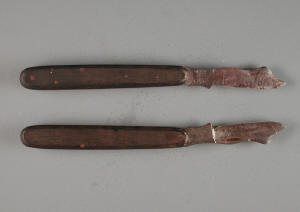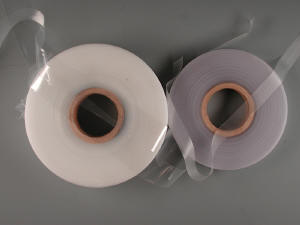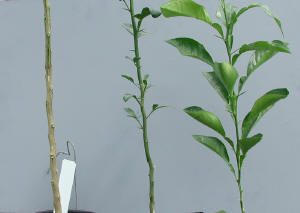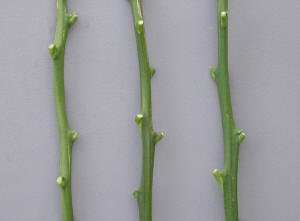
Home:
Grafting Tips:
TAMU Grafting:
Fruit Trees:
Citrus Trees:
Around the
yard:
Useful stuff:
Our Edible Landscaping:
Talbert Farms:
18,000 visitors since the beginning
Visitors since 20Feb05

Home Fruit Production-T-Budding Citrus
Julian W. Sauls, Ph.D.
Professor and Extension Horticulturist
Texas Cooperative Extension
August 1, 2001
While it is called T-budding, the process being described is technically an inverted-T. This same procedure is also used to bud a number of woody plants, including all citrus types, peaches, nectarines, plums, apples, grapes, roses and others. T-budding can be done anytime the bark of the rootstock is "slipping", i.e., the bark separates easily from the underlying wood. For citrus in subtropical areas, the bark slips from early spring through late fall. In greenhouse production and in tropical areas, the bark slips anytime the plant is in active growth--which is practically year-round.
In many commercial citrus-growing areas of the U.S. and the world, budwood is collected only from sources that are certified to be free of a number of viral diseases. Quarantines exist to prevent the movement of citrus propagation materials from one region, state or country to another so as to preclude the spread of citrus diseases to other citrus areas. To obtain budwood from any other citrus area is illegal under either state or federal law or both.
Materials
| Budding knives are extremely thin-bladed, with both right-handed and
left-handed versions. Image 1 shows opposite sides of a typical right-handed
budding knife--the side of the blade shown on the upper knife is flat (unground)
while the opposite side (the lower knife) is ground down to the cutting edge.
Many budders prefer high carbon steel blades (rather than stainless steel)
because they are more easily kept sharpened to a razor edge. The best of pocket knives are usually too thick-bladed to use for budding. Utility knives with replaceable razor blades may be the better choice. Blade thinness and sharpness are critical for successful budding, as a thick or dull blade causes jagged cuts which do not "take" readily. |
 1. Right handed budding knives |
 |
Most budding tape is either clear, very thin polyethylene (at left in Image 2) or somewhat thicker, opaque polypropylene. For home use, strips can be cut from plastic sandwich bags. Neither electrical nor "Scotch"-type tapes are recommended, though plumber's teflon tape should work. The purpose of the tape is to exert a little pressure on the inserted bud, to keep out excess moisture and to protect the bud while the cut surfaces heal and begin to grow together. |
| Seedling rootstocks of at least pencil diameter are usually the easiest for
beginners, although both smaller and much larger stocks can be budded
successfully. Image 3 shows three seedlings, all of which are buddable. The
seedling on the left was used for most of the subsequent images of the actual
budding process. Budwood for home use may be collected from any tree of the desired variety--in most cases from friends, relatives, neighbors or local nurseries. Each of the major citrus-producing states have budwood certification programs which sell virus-free budwood to residents. Because citrus trees typically have four or more growth flushes annually, there should always be usable budwood. |
 3. Seedling rootstock for budding |
|
4. Citrus Budsticks |
In Image 4, the budstick at left is the best, the middle one can be used with good
technique, but the one at right is too angular. Each of these three budsticks
represent a different growth flush of the same branch--the one on the left having
developed in the early spring, the middle one in late spring and the one at right in
mid-summer. If you look closely at the second bud up from the bottom on each
budstick, you will see that the bud and surrounding twig on the leftmost budstick
is round and plump while that of the rightmost is angular and skinny. If left on the
tree, the budstick at right would have looked like the one in the middle after the
next growth flush and then like the one on the left after the second growth flush. Budwood should be placed in closeable plastic bags and kept cool until use. For storage longer than a couple of hours, the bag should be placed in the refrigerator. Under such conditions, citrus budwood can be stored for several weeks, if absolutely necessary. |
BuddingPg1.html
